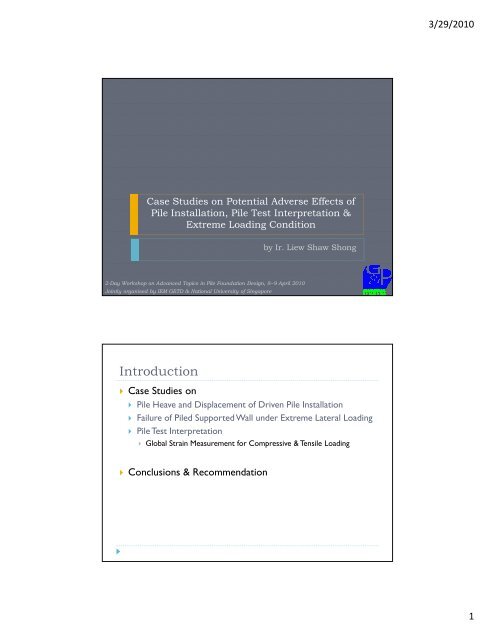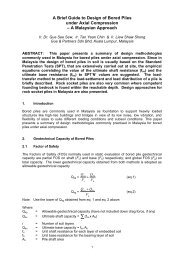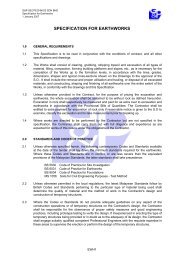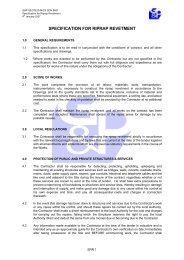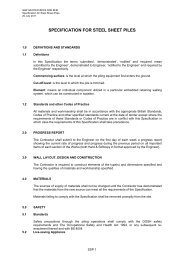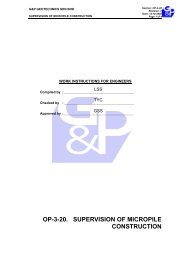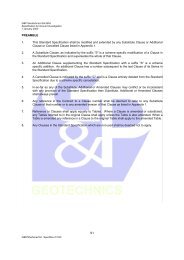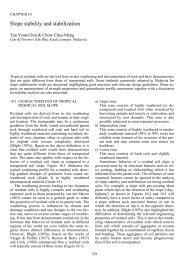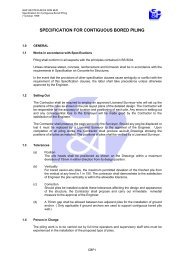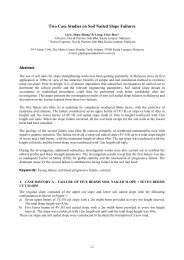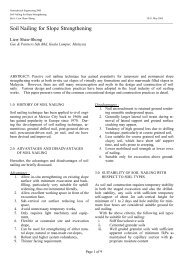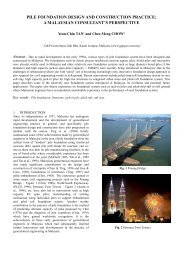Case Studies on Potential Adverse Effects of Pile ... - Gnpgeo.com.my
Case Studies on Potential Adverse Effects of Pile ... - Gnpgeo.com.my
Case Studies on Potential Adverse Effects of Pile ... - Gnpgeo.com.my
You also want an ePaper? Increase the reach of your titles
YUMPU automatically turns print PDFs into web optimized ePapers that Google loves.
3/29/2010<br />
<str<strong>on</strong>g>Case</str<strong>on</strong>g> <str<strong>on</strong>g>Studies</str<strong>on</strong>g> <strong>on</strong> <strong>Potential</strong> <strong>Adverse</strong> <strong>Effects</strong> <strong>of</strong><br />
<strong>Pile</strong> Installati<strong>on</strong>, <strong>Pile</strong> Test Interpretati<strong>on</strong> &<br />
Extreme Loading C<strong>on</strong>diti<strong>on</strong><br />
by Ir. Liew Shaw Sh<strong>on</strong>g<br />
2-Day Workshop <strong>on</strong> Advanced Topics in <strong>Pile</strong> Foundati<strong>on</strong> Design, 8~9 April 2010<br />
Jointly organised by IEM GETD & Nati<strong>on</strong>al University <strong>of</strong> Singapore<br />
Introducti<strong>on</strong><br />
<str<strong>on</strong>g>Case</str<strong>on</strong>g> <str<strong>on</strong>g>Studies</str<strong>on</strong>g> <strong>on</strong><br />
<strong>Pile</strong> Heave and Displacement <strong>of</strong> Driven <strong>Pile</strong> Installati<strong>on</strong><br />
Failure <strong>of</strong> <strong>Pile</strong>d Supported Wall under Extreme Lateral Loading<br />
<strong>Pile</strong> Test Interpretati<strong>on</strong><br />
Global Strain Measurement for Compressive & Tensile Loading<br />
C<strong>on</strong>clusi<strong>on</strong>s & Re<strong>com</strong>mendati<strong>on</strong><br />
1
3/29/2010<br />
Overview<br />
Comm<strong>on</strong> problems <strong>of</strong><br />
installing displacement<br />
piles in s<strong>of</strong>t ground<br />
Design robustness <strong>of</strong> piled<br />
supported wall<br />
Comm<strong>on</strong> overlooked<br />
issues <strong>of</strong> pile testing<br />
instrumentati<strong>on</strong><br />
<str<strong>on</strong>g>Case</str<strong>on</strong>g> 1: <strong>Pile</strong> Heave & Lateral Soil Displacement<br />
Rapid pile installati<strong>on</strong> in in<strong>com</strong>pressible s<strong>of</strong>t soil induces<br />
Vertical heave in shallow depth (relatively less c<strong>on</strong>finement from<br />
weight <strong>of</strong> overburden soils)<br />
Lateral displacement in deeper depth (with soil c<strong>on</strong>finement)<br />
C<strong>on</strong>sequences :<br />
Up-heaving soil movement causes tensile stress <strong>on</strong> pile & toe lift up<br />
during driving & downdrag after pore presure dissipati<strong>on</strong><br />
Lateral soil displacement causes flexural stress <strong>on</strong> pile & pile<br />
deviati<strong>on</strong><br />
Excessive <strong>com</strong>bined tensile and flexural stresses lead to pile joint<br />
dislodgement<br />
Excessive foundati<strong>on</strong> settlement in post c<strong>on</strong>structi<strong>on</strong> (pile toe<br />
uplifting & downdrag settlement)<br />
2
3/29/2010<br />
<strong>Pile</strong> Joint Dislodgement<br />
<strong>Pile</strong> joints could be dislodged due to excessive flexural<br />
and tensile stresses induced by ground heave and radial<br />
soil displacement<br />
Detectable using High Strain Dynamic <strong>Pile</strong> Test (HSDPT)<br />
Mechanism <strong>of</strong> <strong>Pile</strong> Heave & Soil Displacement<br />
3
3/29/2010<br />
<str<strong>on</strong>g>Case</str<strong>on</strong>g> Study - HSDPT<br />
M<strong>on</strong>itoring <strong>of</strong> pile top settlement during the HSDPT restrike<br />
tests is summarised as below:<br />
Cumulative <strong>Pile</strong> Top<br />
Settlement (mm)<br />
Up<strong>on</strong> resting 7-t<strong>on</strong> hammer<br />
<strong>on</strong> pile top<br />
<strong>Pile</strong> C <strong>Pile</strong> A <strong>Pile</strong> B <strong>Pile</strong> D <strong>Pile</strong> E<br />
80 98 125 103 92<br />
At the end <strong>of</strong> Restriking Test 275 399 497 186 182<br />
<str<strong>on</strong>g>Case</str<strong>on</strong>g> Study - HSDPT<br />
<strong>Pile</strong> B<br />
Initial Blow<br />
One <strong>Pile</strong> Length (12m)<br />
was DETECTED with<br />
Major Disc<strong>on</strong>tinuity at<br />
‘toe’ (reflecti<strong>on</strong>)<br />
4
3/29/2010<br />
<str<strong>on</strong>g>Case</str<strong>on</strong>g> Study - HSDPT<br />
<strong>Pile</strong> B<br />
Blow No. 4<br />
First Joint Disc<strong>on</strong>tinuity<br />
closed up after few blows;<br />
Two <strong>Pile</strong> Lengths was<br />
revealed with another<br />
Major Disc<strong>on</strong>tinuity at<br />
new ‘toe’ (reflecti<strong>on</strong>)<br />
<str<strong>on</strong>g>Case</str<strong>on</strong>g> Study - HSDPT<br />
<strong>Pile</strong> B<br />
Blow No. 17<br />
Sec<strong>on</strong>d Major Joint<br />
Disc<strong>on</strong>tinuity also<br />
disappeared;<br />
Total <strong>of</strong> Three <strong>Pile</strong><br />
Lengths was observed<br />
5
3/29/2010<br />
<str<strong>on</strong>g>Case</str<strong>on</strong>g> Study - HSDPT<br />
<strong>Pile</strong> B<br />
End <strong>of</strong> Blow<br />
Minor velocity reflecti<strong>on</strong>s<br />
were observable at first<br />
and sec<strong>on</strong>d pile joints<br />
<strong>Pile</strong> Heave M<strong>on</strong>itoring Program<br />
Y<br />
X<br />
Z<br />
6
3/29/2010<br />
<strong>Pile</strong> Heave M<strong>on</strong>itoring Result<br />
30<br />
25<br />
Measured <strong>Pile</strong> Heave (mm)<br />
20<br />
15<br />
10<br />
5<br />
<strong>Pile</strong> No.1<br />
<strong>Pile</strong> No.3<br />
<strong>Pile</strong> No.4<br />
<strong>Pile</strong> No.5<br />
<strong>Pile</strong> No.6<br />
<strong>Pile</strong> No.7<br />
<strong>Pile</strong> No.8<br />
<strong>Pile</strong> No.9<br />
<strong>Pile</strong> No.10<br />
<strong>Pile</strong> No.11<br />
<strong>Pile</strong> No.12<br />
0<br />
1 2 3 4 5 6 7 8 9 10 11 12<br />
<strong>Pile</strong> Installati<strong>on</strong> in Sequence<br />
Summary <strong>of</strong> <str<strong>on</strong>g>Case</str<strong>on</strong>g> 1<br />
Ground heave & radial soil displacement due to rapid<br />
installati<strong>on</strong> <strong>of</strong> displacement pile in s<strong>of</strong>t in<strong>com</strong>pressible s<strong>of</strong>t clay<br />
can pose serious integrity problem <strong>on</strong> pile foundati<strong>on</strong>.<br />
Soluti<strong>on</strong>s :<br />
Use larger pile spacing & reduce rate <strong>of</strong> clustered pile installati<strong>on</strong> for<br />
adequate time for dissipati<strong>on</strong> <strong>of</strong> excess pore pressure<br />
Simultaneous pile installati<strong>on</strong> at mirror pile locati<strong>on</strong> from centre<br />
outwards to minimise net lateral displacement, but this improves<br />
nothing <strong>on</strong> ground heave<br />
Str<strong>on</strong>ger pile structural strength & joint to withstand tensile &<br />
flexural stresses<br />
Staggered pile installati<strong>on</strong> sequence or install piles at alternate<br />
locati<strong>on</strong>s<br />
Restrike all piles with HSDPT to detect pile integrity if ground or soil<br />
heave is observed.<br />
7
3/29/2010<br />
<str<strong>on</strong>g>Case</str<strong>on</strong>g> 2: <str<strong>on</strong>g>Case</str<strong>on</strong>g> study <strong>on</strong> <strong>Pile</strong>d Supported Wall<br />
Failure<br />
8m RS Wall + 2m L-Shaped RC Wall<br />
Foundati<strong>on</strong> : Vertical piles + Raked <strong>Pile</strong>s (3 rows each)<br />
400mm thick RC Slab<br />
3~3.5m RC M<strong>on</strong>so<strong>on</strong> Drain in fr<strong>on</strong>t <strong>of</strong> Wall<br />
Failure occurred <strong>on</strong> 4 Jan 2007<br />
When RS Wall reached s<strong>of</strong>fit <strong>of</strong> L-Shaped RC Wall<br />
REINFORCED SOIL<br />
WALL<br />
WELL<br />
COMPACTED<br />
GRANULAR FILL<br />
TO WALL<br />
SPECIALIST<br />
SPECIFICATION<br />
6 5 4 3 2 1<br />
8
3/29/2010<br />
Site C<strong>on</strong>diti<strong>on</strong>s<br />
Soil C<strong>on</strong>diti<strong>on</strong>s<br />
Top 4~5m Fill : medium stiff clayey Silt and clayey Sand (N =<br />
6 to 10)<br />
4~8m very s<strong>of</strong>t to s<strong>of</strong>t Clay (S u = 40kPa)<br />
8~18m Stiff Sandy Silt (N= 10~30)<br />
Fill Platform: Cohesive lateritic soils<br />
Wall Backfill: Granular Materials<br />
Groundwater Level<br />
RL14m to RL18m<br />
Rainfall Records<br />
Intense antecedent rainfall from 10 Dec 06 to 29 Dec 06<br />
before failure<br />
Triggering midnight rainfall (20mm/hr) <strong>on</strong> 3 Jan 07<br />
Rainfall - ARI<br />
9
3/29/2010<br />
Rainfall Record<br />
Site Observati<strong>on</strong><br />
Panels<br />
Wet panels & traces watermark shown water seeping out<br />
at the panel joints<br />
The highest level <strong>of</strong> observed water seeping was<br />
immediately below 2m high L-shaped RC wall<br />
∴ Evidence <strong>of</strong> high water table behind the wall panel<br />
<strong>Pile</strong> Foundati<strong>on</strong><br />
Flexural damage <strong>of</strong> pile body at 1.75m to 2m below slab<br />
s<strong>of</strong>fit level<br />
Significant rotati<strong>on</strong> <strong>of</strong> upper part <strong>of</strong> pile above the plastic<br />
hinge<br />
∴ Likely due to excessive lateral load <strong>on</strong> piles<br />
10
3/29/2010<br />
1.5m<br />
1.5m<br />
Water<br />
seepage<br />
sign<br />
1.5m<br />
RL 20.2m<br />
1.5m<br />
Ch 0m<br />
Water<br />
seepage<br />
sign<br />
M<strong>on</strong>so<strong>on</strong> Drain<br />
11
3/29/2010<br />
RL 27.0m<br />
2m top RC panel<br />
1.5m<br />
Water<br />
seepage<br />
sign<br />
Precast<br />
RC panel<br />
M<strong>on</strong>so<strong>on</strong> Drain<br />
Damaged Foundati<strong>on</strong> <strong>Pile</strong>s<br />
Raked pile<br />
RL 18.6m<br />
Raked pile<br />
1.8m<br />
Damaged<br />
c<strong>on</strong>diti<strong>on</strong><br />
12
3/29/2010<br />
Investigati<strong>on</strong> Approach<br />
Examine induced Axial & Lateral Forces and Moments<br />
<strong>on</strong> <strong>Pile</strong>s at Design C<strong>on</strong>diti<strong>on</strong> & Failure<br />
Use <strong>of</strong> Lateral earth pressure theory<br />
Piglet to <strong>com</strong>pute pile group load distributi<strong>on</strong><br />
Check FOS against<br />
<strong>Pile</strong> axial capacity<br />
<strong>Pile</strong> lateral capacity<br />
<strong>Pile</strong> structural adequacy (Moment & Shear)<br />
30m<br />
RL29.0m<br />
RL27.0m<br />
RL28.5m<br />
Original Ground Pr<strong>of</strong>ile<br />
25m<br />
Reduced Level<br />
20m<br />
RL17.1m<br />
RL20.18m<br />
RL18.6m<br />
RL20.5m<br />
RL19.0m<br />
15m<br />
0<br />
10m 20m 30m 40m<br />
13
3/29/2010<br />
30m<br />
RL29.0m<br />
Finished Ground Pr<strong>of</strong>ile<br />
RL27.0m<br />
RL28.5m<br />
25m<br />
Original Ground Pr<strong>of</strong>ile<br />
Temporary Ground Pr<strong>of</strong>ile<br />
During Piling & Wall C<strong>on</strong>structi<strong>on</strong><br />
Reduced Level<br />
20m<br />
RL17.1m<br />
RL20.18m<br />
RL18.6m<br />
RL20.5m<br />
RL19.0m<br />
15m<br />
0<br />
10m 20m 30m 40m<br />
30m<br />
RL29.0m<br />
1m Earth drain<br />
RL27.0m<br />
1m<br />
RL28.5m<br />
25m<br />
Original Ground Pr<strong>of</strong>ile<br />
Temporary Ground Pr<strong>of</strong>ile<br />
During Piling & Wall C<strong>on</strong>structi<strong>on</strong><br />
Reduced Level<br />
20m<br />
RL17.1m<br />
RL20.18m<br />
RL18.6m<br />
RL20.5m<br />
RL19.0m<br />
15m<br />
0<br />
10m 20m 30m 40m<br />
14
3/29/2010<br />
30m<br />
RL29.0m<br />
1m<br />
Earth drain<br />
RL27.0m<br />
1m<br />
RL28.5m<br />
25m<br />
Original Ground Pr<strong>of</strong>ile<br />
Temporary Ground Pr<strong>of</strong>ile<br />
During Piling & Wall C<strong>on</strong>structi<strong>on</strong><br />
Reduced Level<br />
20m<br />
RL17.1m<br />
RL20.18m<br />
RL18.6m<br />
RL20.5m<br />
RL19.0m<br />
15m<br />
0<br />
10m 20m 30m 40m<br />
30m<br />
RL28.5m<br />
Reduced Level<br />
25m<br />
20m<br />
RL19.0m<br />
Original Ground Pr<strong>of</strong>ile<br />
Temporary Ground Pr<strong>of</strong>ile<br />
During Piling & Wall C<strong>on</strong>structi<strong>on</strong><br />
15m<br />
0<br />
10m 20m 30m 40m<br />
15
3/29/2010<br />
View from<br />
Retained<br />
Platform<br />
Design Scenario A (GWT at M<strong>on</strong>so<strong>on</strong> Drain)<br />
30m<br />
RL29.0m<br />
Finished Ground Pr<strong>of</strong>ile<br />
Surcharge = 20kPa<br />
RL27.0m<br />
RL28.5m<br />
25m<br />
Original Ground Pr<strong>of</strong>ile<br />
Temporary Ground Pr<strong>of</strong>ile<br />
During Piling & Wall C<strong>on</strong>structi<strong>on</strong><br />
Reduced Level<br />
20m<br />
RL17.1m<br />
RL20.18m<br />
RL18.6m<br />
RL20.5m<br />
RL19.0m<br />
15m<br />
0<br />
10m 20m 30m 40m<br />
16
3/29/2010<br />
Design Scenario A Results<br />
GWT at Top <strong>of</strong> M<strong>on</strong>so<strong>on</strong> Drain (RL20.18m)<br />
Design Scenario B (1/3 GWT)<br />
30m<br />
RL29.0m<br />
Finished Ground Pr<strong>of</strong>ile<br />
Surcharge = 20kPa<br />
RL27.0m<br />
RL28.5m<br />
25m<br />
Original Ground Pr<strong>of</strong>ile<br />
Temporary Ground Pr<strong>of</strong>ile<br />
During Piling & Wall C<strong>on</strong>structi<strong>on</strong><br />
Reduced Level<br />
20m<br />
RL17.1m<br />
RL20.18m<br />
RL18.6m<br />
RL20.5m<br />
RL19.0m<br />
1/3H<br />
RL22.0m<br />
15m<br />
0<br />
10m 20m 30m 40m<br />
17
3/29/2010<br />
Design Scenario B Results<br />
GWT at 1/3 <strong>of</strong> Retained Height (RL22.0m)<br />
18
3/29/2010<br />
Failure Scenario (GWT at Top<br />
Panel)<br />
30m<br />
RL29.0m<br />
Finished Ground Pr<strong>of</strong>ile<br />
RL27.0m<br />
RL28.5m<br />
25m<br />
Original Ground Pr<strong>of</strong>ile<br />
Temporary Ground Pr<strong>of</strong>ile<br />
During Piling & Wall C<strong>on</strong>structi<strong>on</strong><br />
Reduced Level<br />
20m<br />
RL17.1m<br />
RL20.18m<br />
RL18.6m<br />
RL20.5m<br />
RL19.0m<br />
15m<br />
0<br />
10m 20m 30m 40m<br />
Failure Scenario Results<br />
GWT at Top RS Wall Panel (RL27.0m)<br />
19
3/29/2010<br />
Failure Scenario :<br />
Investigati<strong>on</strong> Findings<br />
At Failure<br />
Prol<strong>on</strong>ged intense antecedent rainfall + Triggering rainfall <strong>on</strong> 3<br />
Jan 2007 caused rising <strong>of</strong> water table above top RS wall panels<br />
Excessive imposed lateral stress exceeds the pile lateral capacity<br />
resulting formati<strong>on</strong> <strong>of</strong> plastic hinge <strong>of</strong> piles leading to collapse <strong>of</strong><br />
central porti<strong>on</strong> <strong>of</strong> wall & pulling the adjoining RS wall<br />
At Service C<strong>on</strong>diti<strong>on</strong><br />
The foundati<strong>on</strong> pile design <strong>com</strong>plies to design requirements<br />
(Adequate safety factors)<br />
20
3/29/2010<br />
C<strong>on</strong>clusi<strong>on</strong>s<br />
• Main causati<strong>on</strong> :<br />
• Excessive lateral wall force due to high water table rise from<br />
prol<strong>on</strong>ged intense rainfall<br />
• Foundati<strong>on</strong> design under service c<strong>on</strong>diti<strong>on</strong> is acceptable<br />
• Attenti<strong>on</strong> shall be given to brittle behaviour <strong>of</strong> c<strong>on</strong>crete<br />
piles taking lateral load with rapid increase <strong>of</strong> earth<br />
pressure when rise <strong>of</strong> groundwater table within the wall.<br />
29 December 2006 - Johor was the worst hit. Heavy rain – the highest recorded in 100<br />
years – caused floods in Johor Baru and several major towns this m<strong>on</strong>th.<br />
21
3/29/2010<br />
Retenti<strong>on</strong> p<strong>on</strong>d full <strong>of</strong> water<br />
Summary <strong>of</strong> <str<strong>on</strong>g>Case</str<strong>on</strong>g> 2<br />
Need careful evaluati<strong>on</strong> <strong>of</strong> design robustness <strong>of</strong> vertical<br />
and sub-vertical piles in taking lateral foundati<strong>on</strong> loading<br />
Soluti<strong>on</strong>s :<br />
Use more raked piles utilising more robust axial pile strength<br />
to resolve lateral imposed loading<br />
Extra drainage capacity for temporary drains for large flat<br />
retained platform<br />
Timely backfilling <strong>of</strong> suitable fill over granular fill <strong>of</strong> RS wall<br />
22
3/29/2010<br />
<strong>Pile</strong> Test Interpretati<strong>on</strong><br />
(using Global Strain Measurement)<br />
Facts <strong>on</strong> Axially Tested <strong>Pile</strong> :<br />
Free standing porti<strong>on</strong> – No fricti<strong>on</strong> interference<br />
Embedded porti<strong>on</strong> – C<strong>on</strong>stant or linearly varying shaft fricti<strong>on</strong> with depth<br />
Tensile cracking in tensile loading affecting axial stiffness <strong>of</strong> <strong>com</strong>posite pile<br />
secti<strong>on</strong><br />
<br />
Factors affecting accuracy <strong>of</strong> pile instrumentati<strong>on</strong><br />
Linearity <strong>of</strong> load-strain calibrati<strong>on</strong><br />
<strong>Pile</strong> shaft resistance pr<strong>of</strong>ile assumed<br />
Instrument locati<strong>on</strong>s for pile axial load measurement<br />
Numbers <strong>of</strong> pile segment movement measurement<br />
Gauge length <strong>of</strong> strain measurement (global / local strain measurement)<br />
C<strong>on</strong>sequences :<br />
Interpreted pile axial load at locati<strong>on</strong> assigned within the gauge length can<br />
be unjustified (unless no interference <strong>of</strong> shaft fricti<strong>on</strong>)<br />
<strong>Pile</strong> Instrumentati<strong>on</strong> & Interpretati<strong>on</strong><br />
Approaches<br />
Identify pile-soil<br />
fricti<strong>on</strong> pr<strong>of</strong>ile<br />
(C<strong>on</strong>stant/ or<br />
Varying fricti<strong>on</strong><br />
with depth)<br />
Best fit measured<br />
articulated movements<br />
<strong>of</strong> instrumented pile<br />
segments & pile top<br />
load with load-strain<br />
calibrati<strong>on</strong><br />
Derive pile axial<br />
load & mobilised<br />
pile-soil fricti<strong>on</strong> by<br />
differentiati<strong>on</strong>s with<br />
respect to pile-soil<br />
fricti<strong>on</strong> pr<strong>of</strong>ile<br />
Load-movement<br />
relati<strong>on</strong>ship <strong>of</strong> each<br />
pile segment for<br />
load transfer<br />
mechanism<br />
Measure<br />
movements <strong>of</strong><br />
instrumented<br />
pile segments<br />
& pile top load<br />
with loadstrain<br />
calibrati<strong>on</strong><br />
Derive pile axial<br />
load at mid-point<br />
from global strain<br />
measurement &<br />
average mobilised<br />
pile-soil fricti<strong>on</strong><br />
over gauge length<br />
Load-movement<br />
relati<strong>on</strong>ship <strong>of</strong><br />
each pile segment<br />
for load transfer<br />
mechanism<br />
Identify pile-soil<br />
fricti<strong>on</strong> pr<strong>of</strong>ile<br />
Measure localised pile<br />
strain and movement <strong>of</strong><br />
instrumented pile<br />
segments independent<br />
extensometers & pile<br />
top load with load-strain<br />
calibrati<strong>on</strong><br />
Derive localised pile<br />
axial load,<br />
interpolated pile<br />
movement pr<strong>of</strong>ile &<br />
mobilised pile-soil<br />
fricti<strong>on</strong><br />
Load-movement<br />
relati<strong>on</strong>ship <strong>of</strong> each<br />
pile segment for<br />
load transfer<br />
mechanism<br />
New Method Glostrext Method Traditi<strong>on</strong>al Method<br />
23
3/29/2010<br />
Load Transfer <strong>of</strong> Test <strong>Pile</strong><br />
f s<br />
C<strong>on</strong>stant<br />
f s<br />
= Zero δ<br />
δ top<br />
P(z)<br />
top<br />
ε(z), δ(z)<br />
δ i<br />
Z<br />
P i<br />
P(z)<br />
f s<br />
= C<strong>on</strong>stant<br />
P i<br />
Linear<br />
δ(z)<br />
F s,i<br />
δ i+1<br />
δ i<br />
P i+1<br />
P i<br />
P(z)<br />
f s<br />
= f s,0<br />
+ mZ<br />
F s,i<br />
P i+1<br />
P i<br />
Quadratic<br />
δ(z)<br />
F s,i<br />
1<br />
m<br />
δ i+1<br />
P i+1<br />
F s,i<br />
P i+1<br />
3 rd Degree<br />
Polynomial<br />
δ toe<br />
Z<br />
Z<br />
Z<br />
Tensile <strong>Pile</strong> Test<br />
24
3/29/2010<br />
Summary <strong>of</strong> <strong>Pile</strong> Instrumentati<strong>on</strong><br />
Proper planning <strong>of</strong> instrumented segment <strong>of</strong> test piles with due<br />
c<strong>on</strong>siderati<strong>on</strong> <strong>of</strong> soil stratificati<strong>on</strong>, pile resistance pr<strong>of</strong>ile (c<strong>on</strong>stant or<br />
varying pr<strong>of</strong>ile with depth)<br />
Tensile cracking <strong>of</strong> c<strong>on</strong>crete under tensile test load leading to<br />
irreversible stiffness alterati<strong>on</strong> shall be carefully assessed for proper<br />
load transfer<br />
Soluti<strong>on</strong>s :<br />
Identify expected pr<strong>of</strong>ile <strong>of</strong> pile-soil fricti<strong>on</strong> based <strong>on</strong> stratificati<strong>on</strong>, soil<br />
c<strong>on</strong>sistency,<br />
Gauge length shall be reas<strong>on</strong>ably small where practical for proper axial load<br />
interpretati<strong>on</strong>, instrumented segment assigned for pile load and movement<br />
Minimum <strong>on</strong>e axial load measurement per material stratum preferably at<br />
the either sides <strong>of</strong> the stratum interface<br />
For material strata with varying pile-soil fricti<strong>on</strong> with depth, more<br />
instrumented segments are needed for refined interpretati<strong>on</strong> <strong>of</strong> axial load &<br />
movement (for best fitting the pile movement pr<strong>of</strong>ile)<br />
At least <strong>on</strong>e axial load measurement near to pile base for load transfer <strong>of</strong><br />
mobilised base resistance<br />
Thank You<br />
25


